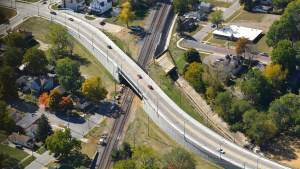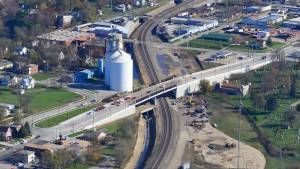Hanson and the Galesburg grade separation projects go way back.
Situated on Interstate 74 in northwest Illinois, Galesburg is home of the heavy-duty, double-track mainline Chillicothe Rail Subdivision. Running on an east-west orientation through the north side of downtown Galesburg, the Chillicothe sub is the transcontinental route connecting Chicago to the ports of Los Angeles and Long Beach, California. In the early 2000s, the city began laying the groundwork for a plan to address problems resulting from the Chillicothe sub, as well as the Mendota rail subdivision. Main and Seminary streets are major arterial routes in Galesburg, and more than 100 trains cross them each day; prior to the grade separations, traffic was stopped for up to eight hours each day because of trains passing through the East Main, West Main and Seminary crossings.
 The design plan for the Bickerdyke Bridge involved curving the roadway alignment so homes built too close to the railroad tracks could be removed and residents relocated to safer properties.
The design plan for the Bickerdyke Bridge involved curving the roadway alignment so homes built too close to the railroad tracks could be removed and residents relocated to safer properties.
City leaders knew the traffic congestion and train noise had become such a problem for residents and business owners that a solution was critical. Kirk Brown, P.E., a senior policy adviser at Hanson, began meeting with Galesburg officials, including then-city engineer Wayne Carl, P.E., in 2004. Over several years, Kirk worked with Carl (currently Galesburg’s director of planning and public works) and the city in an effort to communicate with the Illinois Department of Transportation, Illinois Commerce Commission and Illinois General Assembly, among other groups, to devise a funding plan. Kirk met with the government organizations and helped the city make a case for the bridges that ultimately would ease a major burden on the community. It was crucial for Galesburg to work with these groups, Kirk said, because two of the three projects would involve state roadways.
The three projects included the Donald L. Moffitt Overpass on West Main Street, completed in 2012; the Bickerdyke Bridge at North Seminary Street and Kellogg Street, opened in 2014; and the Rev. Jon A. Sibley Sr. Underpass, unveiled in 2018.
 The addition of the three grade separations in Galesburg, Illinois, including the Donald L. Moffitt Overpass on West Main Street, has helped to relieve traffic congestion and decrease noise from train horns throughout the city.
The addition of the three grade separations in Galesburg, Illinois, including the Donald L. Moffitt Overpass on West Main Street, has helped to relieve traffic congestion and decrease noise from train horns throughout the city.
Kirk said Hanson helped city officials kick off the process. “The city wasn’t sure how to start,” he said. Once planning was underway, “They did an outstanding job of carrying out the strategy,” he added.
Kirk also pointed to Hanson’s established relationship with BNSF Railway Co. as a boon for the projects. “We do a lot of work for BNSF,” he said, “and the fact that they knew us and had worked with us helped move along the process.”
The underpass and two overpasses improved traffic flow in the city and reduced response times for emergency vehicles. The elimination of vehicle and pedestrian crossings increased safety, and the addition of quiet zones decreased disruptive noise from train horns. Historic preservation and land acquisition also were key aspects of the projects. Galesburg is the future home of the National Railroad Hall of Fame, and the project team improved access to the planned museum by curving the alignment of the roadway near the Seminary overpass.
Carl said that, since the bridges were completed, the city’s downtown has been the most active he’s seen it during his 20 years living and working in Galesburg, adding that thriving businesses have brought new life to the area.
“The final product,” Carl said, “is largely based on Hanson’s effort.”